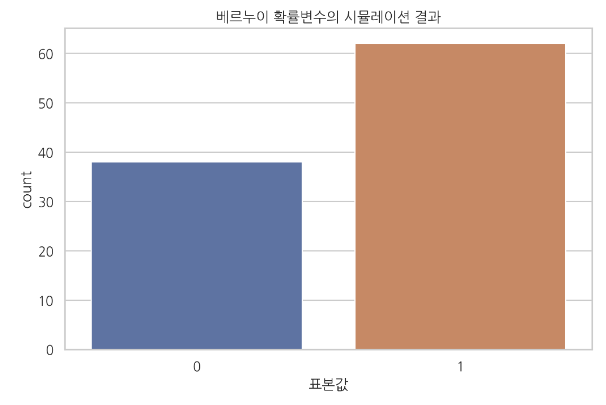================================================================================
https://datascienceschool.net/view-notebook/5e2ee247518f47a6ba2d0894b33c73a3/
================================================================================
result=Bernoulli_trial(trial)
set_of_result={val1,val2}
================================================================================
Bernoulli random variable $$$\subset$$$ Discrete random variable
value=Bernoulli_random_variable(result_from_trial)
set_of_value={0,1}
================================================================================
Probability density function $$$Bern(x;\mu)$$$ of Bernoulli random variable
$$$\text{Bern}(x;\mu) =
\begin{cases}
\mu & \text{if }x=1, \\
1-\mu & \text{if }x=0
\end{cases}$$$
* $$$\mu$$$ : parameter, probability of 1 occuring
* $$$x$$$: variable
* Code
value=Bernoulli_RN(result_from_trial)
print("value",value)
# 0 or 1
prob_val=PDF_of_Bernoulli_RV(value)
print("prob_val",prob_val)
# mu or 1-mu
================================================================================
PDF of PDF of Bernoulli RV
$$$\text{Bern}(x;\mu) = \mu^x(1-\mu)^{(1-x)}$$$
================================================================================
If a random variable X occurs by driving force of PDF of Bernoulli RV,
you can say RV X follows Bernoulli distribution
$$$X \sim Bern(x;\mu)$$$
================================================================================
PMF of Bernoulli random variable
 $$$P(x=0)=0.4$$$
$$$P(x=1)=0.6$$$
================================================================================
Simulation: is to generate samples which will be into random variable
================================================================================
val1=Bernoulli_random_variable(result1_from_trial1)
val2=Bernoulli_random_variable(result2_from_trial2)
# ...
val100=Bernoulli_random_variable(result100_from_trial100)
$$$P(x=0)=0.4$$$
$$$P(x=1)=0.6$$$
================================================================================
Simulation: is to generate samples which will be into random variable
================================================================================
val1=Bernoulli_random_variable(result1_from_trial1)
val2=Bernoulli_random_variable(result2_from_trial2)
# ...
val100=Bernoulli_random_variable(result100_from_trial100)
 ================================================================================
Moments of Bernoulli distribution
* $$$E[X]=\mu$$$
val_1=Bernoulli_RN(result_1_from_trial_1)
...
val_n=Bernoulli_RN(result_n_from_trial_n)
mu=mean(val_1,...,val_n)
================================================================================
$$$Var[X]=\mu(1-\mu)$$$
================================================================================
Parameter estimation
* You get sample from population
* You analyze sample
* You estimate parameters (mean, var, std) of population
================================================================================
$$$\hat{\mu} = \dfrac{\sum_{i=1}^N x_i}{N}= \dfrac{N_1}{N}$$$
N=number_of_sample
N_1=number_of_1_occured
pred_mean_of_pop=mean(N_1,N)
================================================================================
How to use Bernoulli distribution
1. Frequentist usage
- Input: categorical values like 0 or 1, True or False
- Bernoulli distribution decribes ratio of event occuring
2. Bayesian usage
- Output data: categorical values like spam or ham
- Which output value has more large likelihood?
================================================================================
* You get 10 emails
* It turned out 6 emails are spam
* Likelihood of coming email is spam is 60%
* Above situation can be described by Bernoulli distribution which has $$$\mu=0.6$$$
$$$P_Y=Bern(y;\mu=0.6)$$$
* $$$Y$$$: random variable, 0: ham, 1: spam
================================================================================
* Spam email will more likely have some words
* Suppose 4 words which spam email likes to contain
* Suppose email x, x contains 1st and 3rd word
$$$x = \begin{bmatrix} 1 \\ 0 \\ 1 \\ 0 \end{bmatrix}$$$
* If you have multiple emails, you can write
$$$X =
\begin{bmatrix}
1 & 0 & 1 & 0 \\
1 & 1 & 1 & 0 \\
1 & 1 & 0 & 1 \\
0 & 0 & 1 & 1 \\
1 & 1 & 0 & 0 \\
1 & 1 & 0 & 1 \\
\end{bmatrix}$$$
================================================================================
Pattern of spam email
$$$(X_1,X_2,,X_3,X_4)$$$
$$$X$$$: Bernoulli random variable
$$$X_1 \sim Bern(x_1;\mu_1)$$$: probability of spam containing word $$$x_1$$$
$$$X_2 \sim Bern(x_2;\mu_2)$$$: probability of spam containing word $$$x_2$$$
$$$X_3 \sim Bern(x_3;\mu_3)$$$: probability of spam containing word $$$x_3$$$
$$$X_4 \sim Bern(x_4;\mu_4)$$$: probability of spam containing word $$$x_4$$$
================================================================================
You can calculate parameter by using above feature vectors
$$$\hat{\mu}_1 = \frac{5}{6}$$$
$$$\hat{\mu}_2 = \frac{4}{6}$$$
$$$\hat{\mu}_3 = \frac{3}{6}$$$
$$$\hat{\mu}_4 = \frac{3}{6}$$$
================================================================================
Moments of Bernoulli distribution
* $$$E[X]=\mu$$$
val_1=Bernoulli_RN(result_1_from_trial_1)
...
val_n=Bernoulli_RN(result_n_from_trial_n)
mu=mean(val_1,...,val_n)
================================================================================
$$$Var[X]=\mu(1-\mu)$$$
================================================================================
Parameter estimation
* You get sample from population
* You analyze sample
* You estimate parameters (mean, var, std) of population
================================================================================
$$$\hat{\mu} = \dfrac{\sum_{i=1}^N x_i}{N}= \dfrac{N_1}{N}$$$
N=number_of_sample
N_1=number_of_1_occured
pred_mean_of_pop=mean(N_1,N)
================================================================================
How to use Bernoulli distribution
1. Frequentist usage
- Input: categorical values like 0 or 1, True or False
- Bernoulli distribution decribes ratio of event occuring
2. Bayesian usage
- Output data: categorical values like spam or ham
- Which output value has more large likelihood?
================================================================================
* You get 10 emails
* It turned out 6 emails are spam
* Likelihood of coming email is spam is 60%
* Above situation can be described by Bernoulli distribution which has $$$\mu=0.6$$$
$$$P_Y=Bern(y;\mu=0.6)$$$
* $$$Y$$$: random variable, 0: ham, 1: spam
================================================================================
* Spam email will more likely have some words
* Suppose 4 words which spam email likes to contain
* Suppose email x, x contains 1st and 3rd word
$$$x = \begin{bmatrix} 1 \\ 0 \\ 1 \\ 0 \end{bmatrix}$$$
* If you have multiple emails, you can write
$$$X =
\begin{bmatrix}
1 & 0 & 1 & 0 \\
1 & 1 & 1 & 0 \\
1 & 1 & 0 & 1 \\
0 & 0 & 1 & 1 \\
1 & 1 & 0 & 0 \\
1 & 1 & 0 & 1 \\
\end{bmatrix}$$$
================================================================================
Pattern of spam email
$$$(X_1,X_2,,X_3,X_4)$$$
$$$X$$$: Bernoulli random variable
$$$X_1 \sim Bern(x_1;\mu_1)$$$: probability of spam containing word $$$x_1$$$
$$$X_2 \sim Bern(x_2;\mu_2)$$$: probability of spam containing word $$$x_2$$$
$$$X_3 \sim Bern(x_3;\mu_3)$$$: probability of spam containing word $$$x_3$$$
$$$X_4 \sim Bern(x_4;\mu_4)$$$: probability of spam containing word $$$x_4$$$
================================================================================
You can calculate parameter by using above feature vectors
$$$\hat{\mu}_1 = \frac{5}{6}$$$
$$$\hat{\mu}_2 = \frac{4}{6}$$$
$$$\hat{\mu}_3 = \frac{3}{6}$$$
$$$\hat{\mu}_4 = \frac{3}{6}$$$

